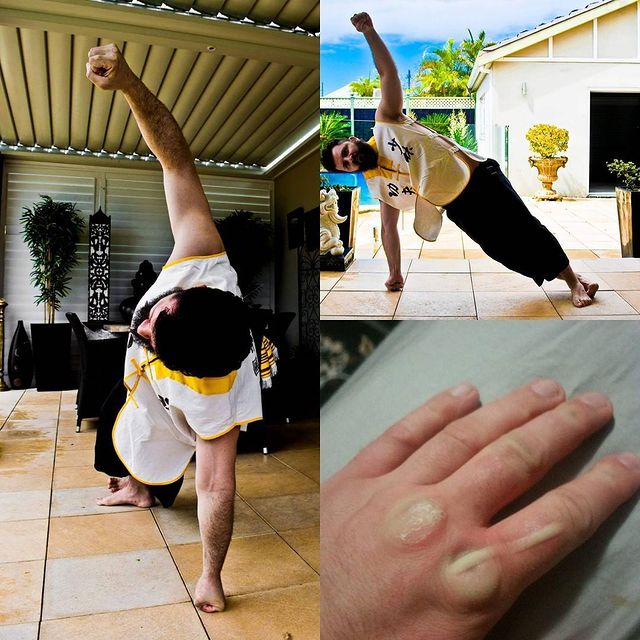Knuckle Conditioning: A How-To Guide

One of the most asked questions from striking martial arts practitioners is about knuckle conditioning methods. They want to know how to strengthen their knuckles to punch harder without damaging their hands.
Here’s our guide on knuckle conditioning. Giving you different options for conditioning your knuckles and safety tips when performing the movements.
What is Knuckle Conditioning, and Why is it Done?
Knuckle conditioning is the act of strengthening your knuckles. The two reasons it’s done are to strengthen a fighter’s hands to prevent injury and punch harder.
When you perform conditioning movements, you lightly damage your knuckles to strengthen them. As you condition your knuckles, calcium gradually develops over your bones.
This calcium build-up strengthens your knuckles while making your punches harder. Many high-level fighters use various types of knuckle conditioning methods in order to punch harder with a lower risk of injury.

Safety Tips for Knuckle Conditioning
There are proper ways to condition your knuckles and incorrect ways that will seriously injure you. Remember these three important safety tips before doing any type of knuckle conditioning.
- Your Form is Most Important
- Focal Points
- Conditioning is Gradual
Proper Form
Punching form isn’t just important for your overall skill but equally important for knuckle conditioning. When your movement is correct, it will result in a powerful punch being landed.
Starting at your feet, moving up the body, and being released at the end of your knuckles. Not just hitting your target but aiming to go through it.
This also goes for your form on push-up variations. Remembering to also focus on form during knuckle conditioning will help in the process.
Focal Points
Always aim to hit with your index and middle knuckles when throwing punches. They are the biggest knuckles on your hand and are designed to absorb more of an impact.
But don’t worry about the other two weaker knuckles. They will also gradually get conditioned as they still absorb the impact of punches.
Conditioning is Gradual
Probably the most important safety tip for knuckle conditioning is to remember that it’s a gradual process. Meaning you’re not bashing your hands into objects at full force to condition your knuckles.
The process of conditioning your knuckles is gradual that’s done with a high volume of solid punches
Knuckle Conditioning Methods
There are numerous types of knuckle conditioning methods that fighters due to strengthen their hands. Here are the four most proven effective methods for strengthening your hands.

Boxing Training
If you want to strengthen your knuckles in order to punch harder, boxing training should be your focus. Every other type of knuckle conditioning is secondary to boxing.
When you throw a high volume of punches, the impact gradually hardens your knuckles. Hitting everything from a bag, mitts or sparring with a teammate.
As you’re technique and timing improve, so does the durability of your hand. The impact of the punches is absorbed by your knuckles, which hardens them as they get used to punching.
If you’re consistent with your boxing training, your knuckles will get tougher and stronger. Be dedicated and do rounds of bag work, mitts, and sparring weekly to improve your hand strength.
Then if you’re careful, you can start doing bag work without gloves. As you punch bare knuckle, your hands and wrist absorb the impact of the punches.
Push-up Variations
Beyond boxing training, push-ups are probably the best exercise to strengthen your knuckles and entire hands/wrists. The great thing about push-ups is various types of push-ups will strengthen both your hands and overall strength.
On the lower difficulty scale, you have basic push-ups and planks that can be performed either with/without knees on the ground. They strengthen the ligaments of your hands and wrists, allowing you to punch harder.
Then on the more difficult side are knuckle push-ups, which are the best push-ups for knuckle conditioning. Start doing knuckle push-ups on a soft mat and gradually start doing them on a smooth and hard surface (Cement, Wood, etc.).
When you perform knuckle push-ups, put most of your weight on your index and middle knuckle. Those are the principal knuckles that are supposed to make contact when you’re hitting an object.
When you perform knuckle push-ups, be sure to start at a low rep number and gradually add more. After weeks of doing various forms of push-ups, you’ll notice a difference in the force of your punches.
Makiwara
A makiwara is a piece of equipment that is used in Karate to strengthen the knuckles of the practitioner. It’s basically just a hard piece of wood with a slim pad over the center.
Karate practitioners throw solid single punches at a time on a makiwara. Never throwing their punches with 100% force, but they are solid enough to make a good impact.
You can purchase a makiwara on Amazon or make your own at home. But make sure the object you’re using has a smooth surface and see that the padding is fully secured.
Rice/Sand Bucket
Rice or sand buckets are an underused but effective way to condition your entire hand. This method is not only used by fighters to strengthen their hands but also by American football players. Specifically the ball carriers like the quarterback.
These bucket exercises are low-impact movements that strengthen the tendons of your hands. Equally important as the knuckles if your goal is to harden your punches.
Fighters do various basic hand movements with little resistance from the weight of the rice/sand. This strengthening method will increase your hand’s flexibility and dexterity.
Putting those together with hardened knuckles will enable you to throw harder punches.
Knuckle Conditioning Methods That We Won’t Encourage
Some other knuckle conditioning methods are, let’s say, a bit extreme. The craziest we’ve heard about is soaking your hands in different substances.
Everything from vinegar, gasoline/petrol, and even a fighter’s own urine. Tyson Fury has claimed that he’s dipped his hands in petrol five minutes a day in order to harden his hands.
We don’t encourage these types of methods, which could pose health risks. You’re on your own if your crazy enough to try them.

What is the Best Knuckle Conditioning Method?
As we said in the knuckle conditioning methods section, boxing training is the best way to condition your knuckle. When you want to condition your knuckles for punching, you should obviously consistently train.
As you consistently train, your knuckles will get stronger from the volume of punches. You will feel and see the difference after prolonged proper boxing training.






